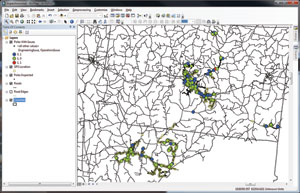ArcUser
Spring 2012 Edition
ArcGIS API for Android App Streamlines Field Inspections
By Jozef Kaslikowski, Tri-County Electric Membership Corporation
This article as a PDF.
An electric cooperative developed an app with ArcGIS API for Android that moved its field equipment inspection process from a paper-based one to a streamlined one using GPS-enabled tablets.
Tri-County Electric Membership Corporation (TCEMC) serves more than 53,000 members in central Tennessee and southern Kentucky. For several years, TCEMC has been moving GIS into more and more areas of the cooperative's operation. One of the last untouched processes was inspections of field equipment.
Everything regarding inspections was being tracked on paper and often in multiple ways, from lists of poles beginning at the substation to the more recent printouts of circuits. The process was inefficient and frustrating to both operations personnel and engineering staff members who had to interpret the field notes. Follow-up trips were often needed to correctly identify facilities with issues. This delayed corrective actions. The large amount of data collected on paper made reporting and tracking impractical.
The paper process had endured for one reason: ease of use. Until recently, mobile devices and software were awkward and cumbersome to use. Training users who might not be familiar with computers was difficult, and equipment was expensive (not to mention problems with battery life and data synchronization). The new iPad and Android tablets were cheaper than laptops and provided a new platform for building easy-to-use solutions that can be operated with two fingers. With ArcGIS API for Android, TCEMC's entire basemap and data on all equipment to be inspected could be placed on an Android tablet and taken into the field. Each tablet has GPS capabilites so it can show the user's current location and a camera that can be used to document problem areas.
ArcGIS for Desktop is used to create a basemap, convert it to a tiled map cache by ArcGIS for Server, and automatically downloaded to each tablet each day along with pending inspection requests. Inspections are overlaid onto the basemap using the touchable graphics in the inspection app. The user simply touches the piece of equipment he would like to inspect, and the appropriate form for recording the inspection is displayed. The inspector's name is logged for each inspection, as well as the last good GPS coordinate, the time the form was submitted, the current known attributes of the equipment, and any issues identified during the inspection. At the end of the day, network connectivity is restored, and the completed inspections are automatically uploaded to the GIS database.
System administration is minimal, because every effort was made to automate tasks. Pending inspections are identified by comparing GIS data to the list of inspections that have been recently completed. Identified problems are automatically routed to the appropriate department.
A web-based application was created to manage the resultant corrective actions for the departments as well as incorporating the information into the engineering staking package. Engineering staff can be assigned individual tasks, or tasks can be assigned in bulk based on territories. Operations supervisors can manage their corrective actions based on service areas. Correction tickets can be printed with an included map provided by the same ArcGIS for Server service that the tablets use. Each assignment is tracked, and additional notes can be added at any point. Finally, each department can separately resolve its own issues without affecting the other.
The completed inspections are stored in a Microsoft SQL Server database that is used for reporting and analysis. Since all information is time stamped, the progress of the inspection cycle can be observed using the new query layer and time-aware layer features of ArcGIS 10. By storing the equipment attributes at the time of inspection, changes in equipment between inspection cycles can be tracked.
TCEMC has taken advantage of newly available hardware and Esri APIs to provide an easy-to-use yet powerful inspection tracking system. By building on common consumer-based equipment, TCEMC can choose from among many vendors and different price points. This solution also benefits from custom app deployment and a standard Windows PC development environment.
